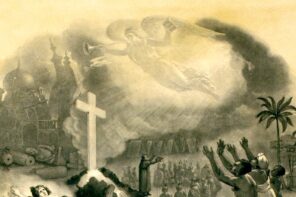Last night, during a beautiful demonstration of public speaking anxiety, Marco Rubio echoed President Obama’s urgency on immigration reform, with added rhetorical emphasis: “We need a responsible, permanent solution to the problem of those who are here illegally. But first, we must follow through on the broken promises of the past to secure our borders and enforce our laws.”
Ah, the fantasy of “secure borders.” For millennia, economic pressures have forced people to move toward more prosperous lands. Nothing has ever stopped that flow, and nothing ever will.
If the United States again becomes the place where better jobs can be found, all the drones, electrified fences, and armed guards that a strapped federal budget can buy won’t stop the flow of illegal immigration. With nearly 6,000 miles of land border plus innumerable seaports and airports awaiting them, people who are hungry or ambitious enough will always find a way to get into the country.
Besides, in our university classrooms we’ve been teaching for years that borders are not walls or barricades. They are not lines drawn on the ground, separating folks on one side from those on the other. Borders are actually broad zones where people come and go in all directions, interacting in all sorts of new and creative ways.
As the scholar of American religions Thomas Tweed says, every nation creates boundaries of the territory that its members “imagine as their space.” He goes on to argue that the very idea of “homeland” is imaginary, subject to refiguring such that “its borders shift over time and across cultures.” “Secure borders” would mean an unchanging and unchangeable community. But that’s a fantasy—you’ll never find it in the real world.
Why, then, is the fantasy so popular? Why is there such a politically irresistible demand for “secure borders”? Tweed’s widely-read book, Crossing and Dwelling, suggests that the study of religion holds a key to the answer. People turn to religion because “humans don’t have their own bearings, and they want to be oriented… they want to find their own place,” he says. To stay oriented and feel “in place,” we build walls around our dwellings, fences around our property, boundaries around our communities, and borders around our nations. For most of human history —and for many humans even today—religions have offered elaborate structures to guide, encourage, and sacralize the process. When border lines have religious sanction they feel permanent and inviolable, and so does our sense of orientation.
But that is only part of what religions do, Tweed claims. He titled his book Crossing and Dwelling because (as he demonstrates at length) religions also guide, encourage, and make sacred the crossing of borders. In pilgrimages, missions, crusades, and many other ways, religious people turn borders into zones of interaction with newly-met others. Even those who stay at home may find their religion moving them to cross social and cultural boundaries. Religions can create new social roles and transform old ones, offer paths to upward mobility (or push people downward), and sometimes call into question the validity of social or economic structures as a whole.
As Tweed says, religious people both “mark and cross all sorts of boundaries,” making borders both secure and insecure.
Second Home
But within any community the emphasis can fall on one or the other side of this paradox, and the emphasis can change over time. Recent American history illustrates that point very well, as another scholar of American religions, Robert Wuthnow, demonstrates in After Heaven, a book that offers a unique, if indirect, insight into the current debate on immigration reform.
Wuthnow first set out to understand the distinctive spiritual style of the 1950s. Reading the religious literature of that era and interviewing folks who had lived through it, the theme he found front and center, over and over again, was the church or synagogue as a sacred dwelling place, a second home.
Probing the meaning of “dwelling,” Wuthnow too found that it offered orientation: “To inhabit sacred space is to know its territory.” But he probed deeper: “A spirituality of dwelling requires sharp symbolic boundaries to protect sacred space from its surroundings.” We only get our bearings and feel that a place is our own when we can contrast it with another place that is not ours. We know we are “here” because we’re not “there.”
When we feel oriented we feel in control of ourselves and our lives. Outside the boundaries of “our place” we would be disoriented and lose control. So “out there” symbolizes danger: “Spiritual sanctuaries [are] fortresses whose walls need to be protected from exterior threats so that life inside could be kept under control.” The dwelling offers “a sheltering canopy that protects people from chaos.” Inside its walls life feels under control because it is so predictable, so “tightly bounded and hierarchical, prescribing behavior through a formalized set of rules” that create rigid social boundaries.
For all these reasons, as long as we are in “our place,” “in here,” we feel safe and secure. A dwelling “provides security by protecting with high walls”—if the walls and boundaries themselves are kept secure.
In the ’50s, with its cold war and religious revival, this symbolic meaning of dwelling became closely linked to patriotism: “Being a good American was a way of exhibiting faith, and both depended on keeping intruders out.” So the whole nation was widely imagined as a sanctuary/fortress, who borders had to be kept inviolable lest intruders invade and destroy the nation.
The imagined threat came, of course, from “the communists.” Americans “feared that their fortress could be invaded at any time. They spent increasing amounts on national defense, built bomb shelters, and searched for subversives in their midst.” But none of this made the nation seem more secure. In fact, the more feverishly Americans tried to make their borders and themselves invulnerable, the more they convinced themselves that they were truly insecure.
By the late ’60s the whole system was breaking down, and a new form of spirituality emerged. Though Wuthnow calls it “seeking,” it has all the hallmarks of what Tweed calls “crossing.” Boundaries, borders, and sheltering walls no longer seemed to matter so much. Rather than stay safely at home, people wanted to take “journeys,” “explore new vistas,” go where everything is “fluid” and all seems possible. If it was unpredictable and chaotic, the risks seemed worthwhile because of the payoff: an unprecedented sense of freedom.
The new spirituality of “seeking” and “crossing” was understandably frightening to many Americans. They fought back with what Wuthnow calls a “struggle for spiritual discipline that gained prominence in the 1980s and that continues” today. “Discipline was promoted in the name of social order itself, almost as if clear rules… could be substituted for the sacred dwellings in which Americans were presumed to have lived in the past.”
But there was no way to go back to the “dwelling” society of the ’50s. The “new preachments about moral and spiritual discipline… came to be a symbolic way of expressing concern about the wrongdoing of others more than a means of recapturing some lost sense of certainty about the sacred self.”
This drama, too, was played out in the political arena: “Nowhere was the call for moral and spiritual discipline more evident than in the rhetoric of the Reagan White House,” which preached “toughness” and “a return to simple and straightforward moral principles” and whipped up renewed cold war fervor.
Yet Reaganism, like the walls and boundaries it promoted, was largely a matter of symbolism. Wuthnow quotes Reagan scholar Michael Paul Rogin: “To represent toughness it is best to operate in a symbolic universe protected from the real-world obstacles that might threaten that toughness or expose its punitive character.”
Now the vast political movement inspired by Ronald Reagan is demanding the fantasy of “secure borders” as the price for immigration reform. Tweed and Wuthnow point to a logical explanation. What we really have here is a contest between two modes of American spirituality, with the nation’s borders as the symbolic playing field on which the contest is fought out.
Liberals want a path to citizenship for the roughly 11 million undocumented residents now in the country, without any stipulation that the borders first be assuredly secure. Liberals may reject that stipulation because it is so unrealistic. But, as Tweed and Wuthnow suggest, they are also acting out their own spiritual/cultural values. Liberals see porous borders as a symbol of freedom: free movement, free choice, and the free creativity generated by the intermingling of peoples.
To conservatives, the very presence of so many Illegal “aliens” proves that the borders they once imagined as the key to a safe, orderly life have long been crumbling around them. To give undocumented people legal status would be further proof that the nation’s walls and the security the walls are supposed to provide have vanished. So conservatives demand the reassurance of a guarantee that the borders will henceforth be 100% absolutely secure.
It sounds like the conservatives have used Wuthnow’s analysis of Reaganism as their script. They demand clear rules and a tough, punitive, disciplinary approach to immigration, focusing on “concern about the wrongdoing of others”—and all detached from the real world. But detachment from reality is no impediment for conservatives. On the contrary it enhances the appeal of “secure borders,” since that ideal so obviously takes them just where they want to be: out of the messy complexities of reality and into the satisfying realm of pure symbolism.
It’s easy to see the symbolic meaning behind their rhetoric: nostalgia for the patriotic spirituality of the cold war era, when most Americans imagined that their nation had “sharp symbolic boundaries” that made it a fortress, “whose walls needed to be protected from exterior threats so that life inside could be kept under control”; a nation where “being a good American… depended on keeping intruders out.”
Behind that nostalgia it’s easy to see a deeper nostalgia for the sense of orientation, order, control and certainty that the spirituality of dwelling ideally provides, all so powerfully symbolized by those sacred words “secure” and “borders.”
Unfortunately conservatives don’t seem to see the irony that history teaches. The feverish quest for “national security” in the 1950s and early 1980s only underscored America’s sense of insecurity and made the nation seem less secure. Now, too, the more we spend on guaranteeing absolutely “secure borders,” the more we will reinforce our fears that the border may not be secure. The faster we chase the elusive goal of security, the further into the distance it recedes. This is always the sad fate of people who depend on walls, boundaries, and borders to make life worth living.
Nevertheless, if President Obama’s State of the Union address last night (and the GOP response to it) are any indication, the immigration reform process will likely end up in compromise, proving that American society is like a religion in at least one respect: it values both crossing and dwelling and will not entirely give up either one.




